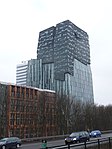SC Buitenveldert
1901 establishments in the NetherlandsDutch football club stubsFootball clubs in AmsterdamFootball clubs in North HollandFootball clubs in the Netherlands
Sportclub Buitenveldert is a Dutch football (soccer) club from the neighborhood Buitenveldert in Amsterdam. It was founded in 1974. In 2020–21, the club has a women's team in Hoofdklasse and a men's team in the Derde Klasse. The women's team has in the past made it to the Topklasse.
Excerpt from the Wikipedia article SC Buitenveldert (License: CC BY-SA 3.0, Authors).SC Buitenveldert
Gustav Mahlerlaan, Amsterdam Zuid
Geographical coordinates (GPS) Address Nearby Places Show on map
Geographical coordinates (GPS)
| Latitude | Longitude |
|---|---|
| N 52.336111111111 ° | E 4.865 ° |
Address
Sportpark Buitenveldert
Gustav Mahlerlaan
1081 LA Amsterdam, Zuid
North Holland, Netherlands
Open on Google Maps








